Outdoor Furniture Blog | Casual Furniture World
Every time you walk into Casual Furniture World, our mission is to help you create the outdoor space of your dreams
How Much Does it Cost to Run a Gas Fireplace?

If you’re looking for a cost-effective, but cozy home heating solution for your family, there is nothing better than a gas fireplace. Gas fireplaces offer plenty of warmth without all of the mess and maintenance of their traditional wood-burning counterparts. While we love gas fireplaces and wood stoves equally at Casual Furniture World, there is nothing quite like the ability to power your fireplace with the push of a button.
At Casual Furniture World, we understand that before you invest, you’d probably like to know more about the costs associated with gas fireplaces, such as their installation and daily operation. While the cost of a gas fireplace does have an initial investment on the front end, gas fireplaces, gas logs, and gas fireplace inserts are far more affordable than you’d think! If you’d like to learn more about the cost of gas fireplaces, and the additional value they can bring your home, then continue reading.
Understanding the Variables of Gas Fireplace Costs
It is important to understand that many variables determine the cost of running a gas fireplace. For instance, before you purchase a gas fireplace, you’ll have to consider the size of the room that needs heating. Is this a regular family room or an entire basement? These are the questions our gas fireplace technicians will ask you before installation, so we can find a style that suits your home heating needs. Having dimensions of the room you’ll be heating is going to provide you, and our technicians, with a better idea of how much it’s going to cost to run a gas fireplace.
Additionally, based on the preexisting connection in your home, our team will determine if you need a gas fireplace unit that runs on propane or natural gas. These two types of fueling methods aren’t very different from one another, but natural gas is slightly more cost-effective than propane. However, propane is known for its energy efficiency compared to natural gas. All in all, both fueling methods have their advantages and disadvantages, it just depends on what you currently have running in your home.
Outside of the fueling method, you’ll also have to take the number of BTU's or therms the unit uses per hour into consideration. BTU’s, known as British Thermal Units, are designed to raise the temperature in a room. The way a BTU works is that one BTU has the power to raise one pound of water by one degree Fahrenheit.
To recap, the cost of a fireplace is determined by:
- The dimensions/size of the room you’re heating
- The type of fuel used to operate your gas fireplace
- The number of BTU’s per hour used to heat the room
Once this information is acquired, it is fairly simple to determine the cost of operating a gas fireplace. You just have to take a few additional factors into account.
Consider Gas Fireplace Installation Costs
If you already have a gas fireplace installed in your home, then you don’t have to worry about the additional cost of a gas fireplace installation. However, if this is the first time you’re shopping for a gas fireplace, then you’ll also have to consider the initial installation costs before running your brand new gas fireplace.
The average cost to install a gas fireplace can fluctuate because of whether or not you have a preexisting ventilation system in your home. If you need critical ductwork or repairs to your chimney and want a vented gas fireplace, then this additional work will raise your total installation price. However, there are ways to bypass this vent work if you opt to install a vent-free fireplace. However, if you’d like a vented or direct vent fireplace, then this additional work may or may not be necessary before installation.
Additionally, you have to consider the actual cost of your fireplace model. Whether you have a gas fireplace, gas log fireplace insert, vent-free gas logs, or vented gas logs - all of these different styles have a different cost. Your decision is going to impact the total cost of your gas fireplace installation, and the annual cost to operate your fireplace.
The price of your fireplace is dependent on a few different factors, such as the brand of your gas fireplace, the amount of installation work that must be done to your existing chimney, or if your ductwork needs repairing.
Ultimately, the type of ventilation system that exists in your home is going to impact the total cost of your gas fireplace installation, and the annual cost to run your fireplace.
How to Determine Your Gas Fireplace Cost
To determine the annual running cost of a gas fireplace, once you know if your unit requires natural gas or propane, you’ll need to know how much your gas provider charges per therm. It should be noted that one therm equals 100,000 BTUs.
To find the average cost, you’ll need to multiply the BTU output of your fireplace by the cost per therm your provider charges. For example, if your gas fireplace puts out 50,000 BTUs and your gas provider charges .60 per therm the mathematical equation would be: 50,000 X 0.60/100,000= 0.30 per hour to operate.
If you needed to determine the cost of a gas fireplace that uses propane, you would need to multiply the fireplace BTU by the cost of propane by the gallon, then divide that number by the BTU equivalent. The formula would be 50,000 X 1.20/100000 = 0.60 per hour.
To determine the monthly cost to run a gas fireplace you would then multiply the hourly operating cost by the hours used during the month. It should be noted that there may be a minimal electrical cost associated with the blowers used by gas fireplaces.
Additionally, the type of fireplace you’re using, and different variables in the room such as vaulted or cathedral ceilings can greatly affect the cost per hour as well. If you have a larger room or an intricate vaulted ceiling, then these variables are going to impact how much it costs to run your gas fireplace.
There are a few other components that can impact the total cost of running your gas fireplace. While a vent-free fireplace is one of the most efficient gas fireplace models, the hot air they emit per hour will immediately rise to the top of the room before it circulates to the rest of your living space. This means that you must first heat the space above you before you will feel the heat at ground level.
While it can take time, the total heat produced is going to make your space feel warmer, and more comfortable. To help disperse the heat output in your room, turn on a ceiling fan if you have one. A better alternative in larger spaces that require more heat circulation might be a direct vent fireplace. Direct vent fireplaces are designed to radiate heat at the ground level, avoiding the expense of heating the space above.
Now, we know that was a lot to process. To help simplify exactly what we mean, we compared the average cost of a gas fireplace that runs on natural gas (NG) and liquid propane (LP). These numbers are based around the average of gas fireplaces used during the winter of 2019 in North Carolina.
- Vent-Free Gas Logs - 36,000 BTU’s
- NG - .25 / hour
- LP - .50 / hour
- Vented Gas Logs - 80,000 BTU’S
- NG - .52 / hour
- LP - 1.05 / hour
In comparison to vent-free gas logs and vented gas logs, direct vent fireplaces can range from 18,000 BTU’s to 60,000 - sometimes more. They also often have more ways to differentiate low to high heat, which allows you to operate the fireplace unit at its most efficient setting, so you can adequately heat your space. For a better idea of what the average cost would look like, you can use the numbers above to help to determine the cost per hour.
The Bottom Line: A Gas Fireplace Costs Less than You Think
Ultimately, it’s not more expensive to install a gas fireplace compared to a traditional wood-burning fireplace or wood stove. While there are installation costs to consider, the annual cost to run a gas fireplace is pretty cost-effective. Plus, you have the additional benefit of no ash, smoke, and minimal maintenance when it comes to your fireplace.
Deciding what is economically responsible for your home and family is going to be the most important choice when you pick a gas fireplace system. While it’s important to pick something that benefits your life, don’t let initial gas fireplace installation costs be a deterring factor when it comes to your heating source. All home heating systems have an initial cost, but in the end, you can’t put a price on comfort.
Whether you want to know more about the cost of gas fireplaces or want to find a model that works for your family, contact Casual Furniture World today for all the assistance you need. Our goal is to make your home inviting and comfortable year-round. Want to learn more about your home heating options? Download our 2020 Gas Fireplace Guide, to see which style is best for your home.


